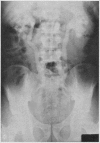Abstract
Three cases of compulsive polydipsia previously diagnosed as diabetes insipidus are presented. Abnormally dilated bladder and pyelocalyceal systems were accompanying features, as previously described for diabetes insipidus, particularly of renal orign. Results of the hypertonic saline (Hickey-Hare) test were positive in only one case. Results of restriction of liquids followed by intravenous injection of vasopressin (Miller test) favoured a diagnosis of complete diabetes insipidus. These two tests cannot, therefore, exclude compulsive polydipsia. The features suggesting a diagnosis of compulsive water drinking are low plasma osmolality, a decrease in 24-hour urine output following water restriction, and abnormal behaviour. The diagnosis is confirmed by an 18-hour dehydration test done after gradual fluid restriction, which favours partial restoration of the papillary osmotic gradient.
Full text
PDF




Images in this article
Selected References
These references are in PubMed. This may not be the complete list of references from this article.
- BARLOW E. D., DE WARDENER H. E. Compulsive water drinking. Q J Med. 1959 Apr;28(110):235–258. [PubMed] [Google Scholar]
- CARTER R. D., GOODMAN A. D. Nephrogenic diabetes insipidus accompanied by massive dilatation of the kidneys, ureters and bladder. J Urol. 1963 Mar;89:366–369. doi: 10.1016/S0022-5347(17)64559-2. [DOI] [PubMed] [Google Scholar]
- CHUNG R. C. H., MANTELL L. K. Urographic changes in diabetes insipidus; report of a case. J Am Med Assoc. 1952 Nov 29;150(13):1307–1308. doi: 10.1001/jama.1952.63680130013008f. [DOI] [PubMed] [Google Scholar]
- EPSTEIN F. H., KLEEMAN C. R., HENDRIKX A. The influence of bodily hydration on the renal concentrating process. J Clin Invest. 1957 May;36(5):629–634. doi: 10.1172/JCI103462. [DOI] [PMC free article] [PubMed] [Google Scholar]
- Harrington A. R., Valtin H. Impaired urinary concentration after vasopressin and its gradual correction in hypothalamic diabetes insipidus. J Clin Invest. 1968 Mar;47(3):502–510. doi: 10.1172/JCI105746. [DOI] [PMC free article] [PubMed] [Google Scholar]
- Linshaw M. A., Hipp T., Gruskin A. Infantile psychogenic water drinking. J Pediatr. 1974 Oct;85(4):520–522. doi: 10.1016/s0022-3476(74)80459-2. [DOI] [PubMed] [Google Scholar]
- Manson A. D., Yalowitz P. A., Randall R. V., Greene L. F. Dilatation of the urinary tract associated with pituitary and nephrogenic diabetes insipidus. J Urol. 1970 Mar;103(3):327–331. doi: 10.1016/s0022-5347(17)61953-0. [DOI] [PubMed] [Google Scholar]
- Miller M., Dalakos T., Moses A. M., Fellerman H., Streeten D. H. Recognition of partial defects in antidiuretic hormone secretion. Ann Intern Med. 1970 Nov;73(5):721–729. doi: 10.7326/0003-4819-73-5-721. [DOI] [PubMed] [Google Scholar]
- Naccarato R., Rizzo A., Sirigu F., Bertaglia E., Previato G., Fiaschi E. Renal histologic and ultrastructural findings in psychogenic polydipsia and diabetes insipidus. Nephron. 1976;16(3):226–235. doi: 10.1159/000180606. [DOI] [PubMed] [Google Scholar]
- Ramsey E. W., Morrin P. A., Bruce A. W. Nephrogenic diabetes insipidus associated with massive hydronephrosis and bladder neck obstruction. J Urol. 1974 Feb;111(2):225–228. doi: 10.1016/s0022-5347(17)59934-6. [DOI] [PubMed] [Google Scholar]
- Silverstein E., Sokoloff L., Mickelsen O., Jay G. E. Primary Polydipsia and Hydronephrosis in an Inbred Strain of Mice. Am J Pathol. 1961 Feb;38(2):143–159. [PMC free article] [PubMed] [Google Scholar]
- Stevko R. M., Balsley M., Segar W. E. Primary polydipsia--compulsive water drinking. Report of two cases. J Pediatr. 1968 Dec;73(6):845–851. doi: 10.1016/s0022-3476(68)80237-9. [DOI] [PubMed] [Google Scholar]
- Ten Bensel R. W., Peters E. R. Progressive hydronephrosis, hydroureter, and dilatation of the bladder in siblings with congenital nephrogenic diabetes insipidus. J Pediatr. 1970 Sep;77(3):439–443. doi: 10.1016/s0022-3476(70)80012-9. [DOI] [PubMed] [Google Scholar]
- VEST M., TALBOTNB, CRAWFORD J. D. Hypocaloric dwarfism and hydronephrosis in diabetes insipidus. Am J Dis Child. 1963 Feb;105:175–181. doi: 10.1001/archpedi.1963.02080040177008. [DOI] [PubMed] [Google Scholar]
- Vaamonde C. A., Presser J. I., Clapp W. Effect of high fluid intake on the renal concentrating mechanism of normal man. J Appl Physiol. 1974 Apr;36(4):434–439. doi: 10.1152/jappl.1974.36.4.434. [DOI] [PubMed] [Google Scholar]
- WELLER C. G., ELLIOTT W., GUSMAN A. R. Hereditary diabetes insipidus: unusual urinary tract changes. J Urol. 1950 Nov;64(5):716–721. doi: 10.1016/S0022-5347(17)68700-7. [DOI] [PubMed] [Google Scholar]
- WHEELER J. S., ADELSON W. J. PITUITARY DIABETES INSIPIDUS ASSOCIATED WITH PROGRESSIVE URINARY TRACT DILATATION. J Urol. 1964 Jul;92:64–67. doi: 10.1016/S0022-5347(17)63888-6. [DOI] [PubMed] [Google Scholar]
- YOON M. C., HONG S. K. Effect of prolonged bodily hydration on the renal concentrating operation. J Appl Physiol. 1961 Sep;16:815–818. doi: 10.1152/jappl.1961.16.5.815. [DOI] [PubMed] [Google Scholar]




